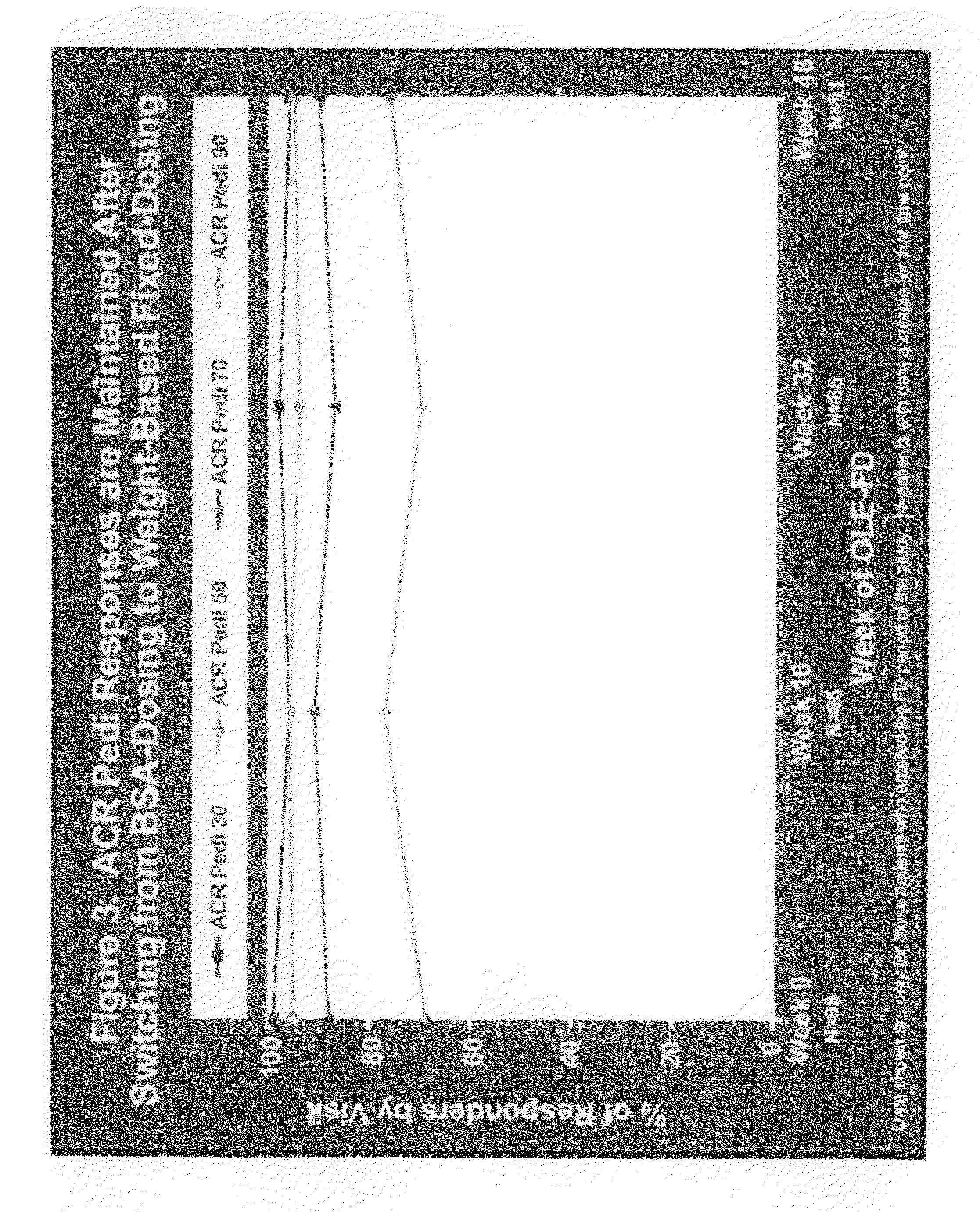Methods for treating juvenile idiopathic arthritis
a technology for idiopathic arthritis and treatment methods, which is applied in the field of treatment methods for juvenile idiopathic arthritis, can solve the problems of identifying a fixed dose effective for all patients in a given population, which is a challenge, and achieves the effects of improving the active joint count, improving the pedacr score, and improving the number of joints
- Summary
- Abstract
- Description
- Claims
- Application Information
AI Technical Summary
Benefits of technology
Problems solved by technology
Method used
Image
Examples
example 1
Long-Term Efficacy and Safety of Adalimumab in Children with Juvenile Rheumatoid Arthritis (JRA): Converting from Body Surface Area Dosing to Fixed Dosing in the Open-Label Extension (OLE) of a Phase III Study
[0202]Adalimumab (ADA), dosed at 24 mg / m2 body-surface-area (BSA) every other week (eow), has been shown to improve signs and symptoms in juvenile rheumatoid arthritis (JRA) patients in a 48-week Phase III, randomized, controlled withdrawal trial (Ruperto, N 48-Week Data From the Study of Adalimumab in Children With Juvenile Rheumatoid Arthritis (JRA). Poster presented at European League Against Rheumatism 2006).
[0203]Patients in the following trial were given the option of entering an open label extension study, with initial continued BSA dosing and a subsequent switch to weight-based fixed dosing (FD).
[0204]The following study examines long term efficacy with adalimumab treatment, and compares efficacy between dosing regimens, weight-based vs. fixed dosing (FD). Thus, the obj...
example 2
Improvements in Individual Disease Components are Sustained With Long-Term Adalimumab Therapy for Polyarticular Juvenile Idiopathic Arthritis
[0217]To control symptoms and prevent increasing disability in children with active polyarticular Juvenile Idiopathic Arthritis (JIA), long-term, effective treatment that controls all aspects of the disease is necessary. Individual ACR Pedi response criteria were analyzed for the 128 patients who entered the open-label extension (OLE) of a Phase III study of adalimumab in the treatment of polyarticular JIA. Measurements of disease activity were performed at each visit, including active joint count (AJC), number of joints with limitation of passive motion (LOM), parent's or patient's assessment of patient's pain (PaP), disability index of the Children's Health Assessment Questionnaire (CHAQ DI), and physician's global assessment of disease activity (PhDA). Observed data were examined for those patients who had been treated with adalimumab throug...
example 3
Summary of Phase III Study Showing Efficacy of Fixed Dose Regimen
[0218]The safety and efficacy of Humira® (adalimumab) were assessed in a multicenter, randomized, withdrawal, double-blind, parallel-group study in 171 children (4 to 17 years old) with polyarticular juvenile idiopathic arthritis (JIA). In the study, the patients were stratified into two groups: MTX-treated or non-MTX-treated. All subjects had to show signs of active moderate or severe disease despite previous treatment with NSAIDs, analgesics, corticosteroids, or DMARDS. Subjects who received prior treatment with any biologic DMARDS were excluded from the study. The study included four phases: an open-label lead in phase (OL-LI; 16 weeks), a double-blind randomized withdrawal phase (DB; 32 weeks), an open-label extension phase (OLE-BSA; up to 136 weeks), and an open-label fixed dose phase (OLE-FD; 16 weeks). In the first three phases of the study, Humira® (adalimumab) was administered based on body surface area at a d...
PUM
| Property | Measurement | Unit |
|---|---|---|
| Weight | aaaaa | aaaaa |
| Weight | aaaaa | aaaaa |
| Weight | aaaaa | aaaaa |
Abstract
Description
Claims
Application Information
 Login to View More
Login to View More - R&D
- Intellectual Property
- Life Sciences
- Materials
- Tech Scout
- Unparalleled Data Quality
- Higher Quality Content
- 60% Fewer Hallucinations
Browse by: Latest US Patents, China's latest patents, Technical Efficacy Thesaurus, Application Domain, Technology Topic, Popular Technical Reports.
© 2025 PatSnap. All rights reserved.Legal|Privacy policy|Modern Slavery Act Transparency Statement|Sitemap|About US| Contact US: help@patsnap.com



